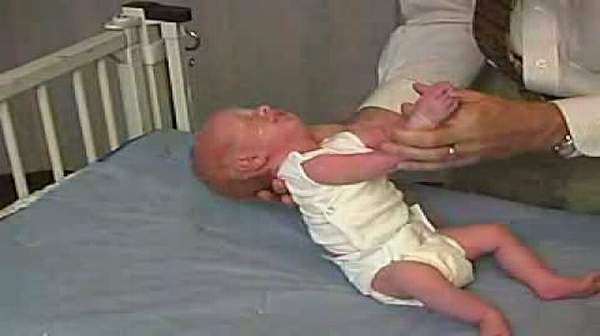Hypotonia is a state of low muscle tone, the condition can affect children or adults. Hypotonia is usually detected at birth or during infancy. If your infant has hypotonia, he or she may appear limp at birth and not be able to keep his or her knees and elbows slightly bent. Hypotonia is not a specific medical disorder, but a potential manifestation of many different diseases and disorders that affect motor nerve control by the brain or muscle strength.
Hypotonia is not the same as muscle weakness, although it can be difficult to use the affected muscles. Muscle weakness sometimes develops in association with hypotonia, however, depending on the cause.
Causes
Muscle tone and movement involve the brain, spinal cord, nerves, and muscles. Hypotonia may be a sign of a problem anywhere along the pathway that controls muscle movement. Causes may include:
- Brain damage or encephalopathy, due to lack of oxygen before or right after birth, or problems with brain formation
- Disorders of the muscles, such as muscular dystrophy
- Disorders that affect the nerves that supply muscles
- Disorders that affect the ability of nerves to send messages to the muscles
- Rare genetic disorders, in which the body cannot properly turn food into energy
- Infections
Genetic or chromosomal disorders, or defects that may cause brain and nerve damage include:
- Down syndrome
- Prader-Willi syndrome
- Tay-Sachs disease
- Trisomy 13
Other disorders that can lead to the condition include:
- Achondroplasia
- Congenital hypothyroidism
- Congenital cerebellar ataxia
- Marfan syndrome
- Poisons or toxins
- Spinal cord injuries that occur around the time of birth
Symptoms
Hypotonia present at birth is often noticeable by the time a child is six months old, if not before. Newborn babies and young children with severe hypotonia are often described as being “floppy” or like a “rag doll”.
- having little or no control of their neck muscles, so their head tends to flop
- feeling limp when held, as though they could easily slip through your hands
- being unable to place any weight on their leg or shoulder muscles
- their arms and legs hang straight down from their sides, rather than bending at their elbows, hips and knees
- finding sucking and swallowing difficult, and they may have a weak cry
- becoming clumsy and falling frequently
- difficulty getting up from a lying or sitting position
- an unusually high degree of flexibility in the hips, elbows and knees
- difficulty reaching for or lifting objects
Types of therapy for hypotonia
There are several types of therapy for hypotonia, these include:
Regular physiotherapy is important to improve muscle tone and prevent contractures.
Physiotherapy aims to improve posture, and co-ordination and strengthen the muscles around the joints of the limbs to provide more stability and support.
Regular exercises are prescribed for this purpose.
Occupational therapy
Occupational therapy helps patients in the activities of daily living.
For example, fine finger skills are focussed upon to improve feeding and dressing etc.
Speech and language therapy
Speech and language therapy is recommended for patients who have speech and swallowing problems due to hypotonia.
This therapy helps develop better control of the jaw and mouth muscles.
Assisted breathing
Patients with hypotonia often suffer from difficulty in breathing at night due to further loss of muscle tone.
These patients need assisted artificial breathing and ventilation through machines.
They are also at risk of repeated respiratory infections that need to be treated. Annual flu vaccination is necessary.
Orthopaedic review
Orthopaedic review is important annually to check for spinal deformities, hip dislocation and joint weakness and slipping (subluxation).
Some patients may need braces and surgical procedures to improve movement and support of the limbs.
Feeding interventions
In babies and children with severe hypotonia and difficulty in feeding, interventions like tube feeding may be needed.
Ideal weight maintenance and adequate nutrition is important part of management.
Specific medication
Babies with myasthenia gravis need specific medication. These are drugs like Neostigmine, Physostigmine etc.
The treatment may often last a life time.
In myasthenia gravis the body’s immune system attacks certain receptors at the neuromuscular junction. Sometimes drugs that suppress the immunity like corticosteroids may be added to regular myasthenia gravis therapy to relieve symptoms of muscle weakness.
Antibiotics
Hypotonia may be caused due to an infection, meningitis or encephalitis.
If antibiotics are administered to fight these infections, symptoms may be reduced.
Therapy for genetic disorders causing hypotonia
Genetic disorders like Down’s syndrome, Prader Willi syndrome, Marfan’s syndrome, Ehler-Danlos syndrome etc. do not always have specific therapy.
These conditions with hypotonia may be treated symptomatically with physical and occupational therapy.
Genetic counselling may be offered to parents regarding future pregnancies.
Therapies are not always needed
Premature babies who are born with hypotonia often recover by themselves as they grow. They may need vigilance against infections, sepsis and feeding difficulties.
Babies with no specific cause of hypotonia called Benign congenital hypotonia often need no therapy apart from physical and occupational therapy.





